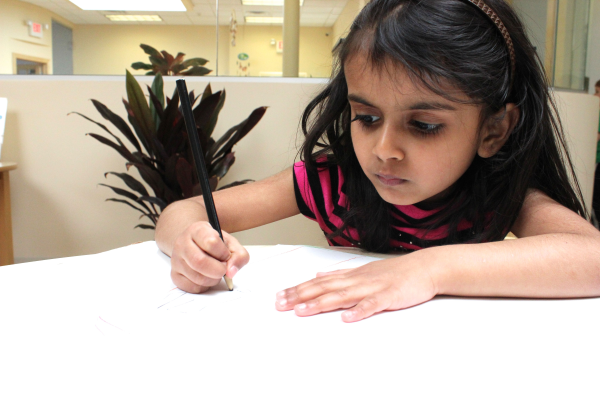Wisconsin Montessori Language and Communication
Some people say that when you enter a Montessori environment, you can hear a pin drop. If that is true, those children are not experiencing humankind’s most important accomplishment – Language. All sentient beings communicate in some form – whether in sounds (i.e. spoken language), body language (think wolves), or movement (think bees); yet only humans have invented the written symbols of language – the written word.
At MorningStar Montessori, there is always a hum of activity – children laughing, children singing, but most importantly, children speaking to one another.
How do children learn language? It is a phenomenon that a very young child born in one country can be brought to live in another country anyplace in the world and learn that country’s language as thoroughly as a native speaker. No adult could hope to learn a foreign language with every nuance and idiosyncrasy as easily as a child, even with a conscientious effort of studying. Dr. Maria Montessori discovered that children from 0 to 6 years old have an Absorbent Mind – that without any effort on the child’s part, he or she could learn one or several languages simultaneously and flawlessly. After the age of 6, that same child would then have to try to learn the language by studying and memorizing grammar, syntax, vocabulary, etc. What happened to the flexible brain that once absorbed the language around it? It became hard-wired – everything learned would now have to be with a conscious effort – the adult mind.
Dr. Maria Montessori discovered that children from 0 to 6 years old have an Absorbent Mind – that without any effort on the child’s part, he or she could learn one or several languages simultaneously and flawlessly. After the age of 6, that same child would then have to try to learn the language by studying and memorizing grammar, syntax, vocabulary, etc. What happened to the flexible brain that once absorbed the language around it? It became hard-wired – everything learned would now have to be with a conscious effort – the adult mind.
If we parents and teachers know that children have only 6 years to receive the very best of a language, then it is our vital responsibility to give them the very best of language – since it is only directly from the adults around them that children learn language.
Milwaukee Area Montessori Encouraged Language Learning
At MorningStar Montessori Cedarburg, we value and encourage both the spoken and the written language. With even the youngest children, the guide gets down eye-to-eye with each child to simply have a conversation: the give-and-take of dialog, the speaking of ideas, the listening, the time, the interest, the acceptance and more.
As a facilitator, the Guide models and encourages proper speech: the use of sentences, correct grammar, pronunciation and syntax. If a child uses improper speech, the Guide repeats what the child said properly so the child can hear proper speech. After a time, the child will begin to repeat after the Guide; soon the child will begin correcting himself – positive learning without pressure or criticism.
At MorningStar Montessori Cedarburg, we incorporate language in everything we do. We give the children rich vocabulary. We give the names of everything – objects, the inside and outside environments, the solar system, the species of animals, bones, leaves, plants, etc. etc. We explain everything that we are doing, whether it’s learning a new material, bandaging a finger, baking bread, or looking at worms in the garden. We read books, play with poetry and rhythm, tell stories, ask questions about show-and-tell items and much more.
Then together, the child and the Guide begin to analyze the sounds of the alphabet and find objects in the environment that begin with those sounds – “a” as in apple, “h” as in house, “o” as in octopus, “t” as in table, etc.
After spending a great deal of time with “sounding out” words (c-a-t) and helping the child to recognize the beginning, ending, and middle sounds, with two fingers the Guide traces a cursive letter made of sandpaper and says the sound - the child does the same. Gradually, the child is learning both how to read and how to write the letters in cursive! Why in cursive, do you ask? To write in circular form is natural to a young child’s development, unlike writing in print. A child scribbles in circles, not in sticks.
Meanwhile, other materials in the Montessori environment help to prepare the child’s hand for writing: clay, painting, pasting, using scissors, the circular motion of washing dishes, scrubbing tables, and polishing, the three-finger-hold on the knobs of the cylinder blocks, playing the bells, the geometric cabinet, the metal insets, etc. etc.
From hearing and speaking language, to analyzing sounds, to writing in cursive, to reading phonetically, to reading everything, to “playing” with grammar - there is no set curriculum or time limit to “teach” language to a child. Instead, by utilizing the beautiful, hands-on Montessori language materials, each child learns individually, according to his or her own ability and needs, and most of all, there is no limit as to what a child can learn in a Milwaukee area Montessori environment.
